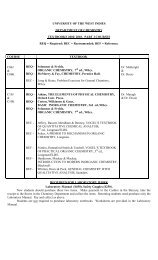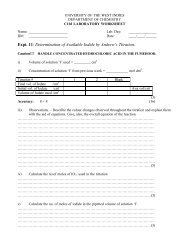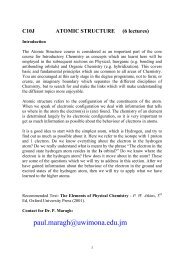Examination <strong>of</strong> whole <strong>and</strong> sectioned sagittal otoliths showed clear patterns <strong>of</strong> marks with alternatinghyaline <strong>and</strong> opaque zones. Whole otoliths <strong>of</strong> specimens less than 270 mm FL were sufficiently transparentto allow ageing under low power light microscopy. Marginal increment analysis (temporal distribution <strong>of</strong>opaque <strong>and</strong> hyaline edges) indicated that there was one opaque (fast growth) zone laid down annually inJuly, <strong>and</strong> one hyaline (slow growth) zone laid down in March.Analyses <strong>of</strong> sagittal otoliths suggested differing ages based on the use <strong>of</strong> whole or sectioned otoliths.Whole otolith analysis indicates a maximum age <strong>of</strong> 6 years, but sectioned otoliths suggest a maximum <strong>of</strong>at least 14 years. This is older than previously known for this species in these waters. <strong>The</strong> majority <strong>of</strong> thel<strong>and</strong>ings nonetheless comprise individuals that are between 1 <strong>and</strong> at least 6 years old. <strong>The</strong> new estimatedages have management implications <strong>and</strong> these are briefly discussed. Otolith weight analyses produced arelationship where Y = 0.0403x - 1.543 (r 2 = 0.9407) for males <strong>and</strong> for females Y = 0.0405x - 1.1716 (r 2= 0.9711). Importantly it is suggested that otolith weight changes with fork length can be used to indicatechanges in overall growth. Otolith radius versus fork length relationship yielded the equation Y = 1.5262x- 3.9574 (r 2 = 0.850). Like otolith weight, these are significant relationships, <strong>and</strong> suggest that they may beused as an indicator <strong>of</strong> overall growth in the lane snapper.ELEFAN (a computerized iterative programme that compares actual with expected modes in lengthfrequencies <strong>and</strong> emphasises similarities) analyses suggest an asymptotic length (Loo) <strong>of</strong> 450 mm FL, <strong>and</strong> aVon Bertalannfy growth rate <strong>of</strong> K = 0.23, with t0 = 0.001 yr-1. <strong>The</strong> present results differ in several aspectsfrom the earlier work <strong>of</strong> Thompson & Munro (1983) who sampled only <strong>of</strong>fshore catches <strong>and</strong> the ages aregreater than Cuban findings based on whole otolith analyses (Claro, 1982; Claro & Reshetnickov, 1981).Similarly, they are somewhat less in maximum age than recent findings (19 years) for Bermudan lanesnapper (Luckhurst, Dean & Reichert, 1998).Management for this <strong>and</strong> other long lived, slower growing species must consider that any changes in thestocks <strong>of</strong> this <strong>and</strong> other fishes, will mean slower recovery from such changes, as compared to the relativelyfaster species recovery formerly suggested by earlier aging research.ReferencesClaro, R. 1982. Ecologia y ciclo de vida de la biajaiba, Lutjanus synagris (Linnaeus) en la plataformacubana. IV. Reproduccion. Rep. de investigacion del instituto de oceanologia. No. 5. Acad. de Cienc.de Cuba. 37pp.Claro, R. & Y.S. Reshetnikov. Ecologia y ciclo de vida de la biajaiba, Lutjanus synagris (Linnaeus), ena plataforma cubana. 1. Formacion de marcas de crecimiento en sus estrcturas. Informe cientificotechnicoNo. 174, Instituto de Oceanologia. Academia de ciencias de Cuba. 29pp.Luckhurst, B.E., Dean, J.M. & M. Reichert. 1998. Age <strong>and</strong> growth <strong>of</strong> lane snapper. Book <strong>of</strong> abstracts;2nd. International Symposium on Fish Otolith Research & Application, Bergen, Norway, June1998. p209.Thompson R. & J.L. Munro. 1983. <strong>The</strong> biology, ecology <strong>and</strong> bionomics <strong>of</strong> the snappers, Lutjanidae; inCaribbean Coral Reef Fishery Resources Ed. J.L. Munro. ICLARM Studies & Reviews 7: 94-10.30
O-11 RESEARCH INTO THE BIOLOGY OF JAMAICANFRESHWATER MACROINVERTEBRATES AND FISHES- DIRECTIONS AND AN OVERVIEWE. J. Hyslop<strong>Department</strong> <strong>of</strong> Life Sciences, MonaDespite being well provided with river systems, Jamaica has seen little published work particularlyon the benthic macroinvertebrate fauna <strong>of</strong> these water bodies. In addition, development, in somecases at a rapid pace, throughout the country, in conjunction with inadequate environmental controlhas resulted in considerable input from anthropogenic processes to the country's river systems, theeffects <strong>of</strong> which, on the faunal communities, have been inadequately documented.<strong>The</strong> present paper sets out to demonstrate that a research programme to address, at least in part, theabove problems is being implemented <strong>and</strong> to discuss in brief the main directions being followed <strong>and</strong>outline some <strong>of</strong> the preliminary findings. In addition the components <strong>of</strong> this research programme <strong>and</strong>their interrelationship are fully discussed.Taxonomic work is concerned with giving names to organisms <strong>and</strong> by extension to identifyingcommon associations or groupings, these include community composition <strong>and</strong> diversity. This in turncan be linked to information on the physico-chemical conditions under which the co munity isfound, including the presence <strong>of</strong> known or suspected pollutants. Rivers are longitudinal systems <strong>and</strong>it is necessary to establish whether changes in community composition <strong>and</strong>/or diversity are as aresult <strong>of</strong> altitudinal gradient (longitudinal zonation) or due to other factors. Some general publishedinformation on benthic macroinvertebrate distribution exists in relation to Jamaica (Boon, Jupp &Lee 1986). Recent detailed studies on the taxonomy <strong>of</strong> trichopterans (caddis flies) have resulted inthe description <strong>of</strong> seven new species <strong>and</strong> two sub-species for Jamaica (Botosaneanu & Hyslop, inpress 1 & 2 ) while work on freshwater Gastropoda indicates a predominance <strong>of</strong> two species <strong>of</strong> thefamily Thiaridae; Melanoides tuberculata <strong>and</strong> Thiara granifera, both <strong>of</strong> which are recentintroductions to the fauna, originally from Africa/Asia (Hyslop, unpublished data).<strong>The</strong> predominance <strong>of</strong> Thiaridae in most river systems has implications for the indigenous gastropodfauna <strong>and</strong> an analagous situation exists with regard to freshwater riverine fishes. Here again theJamaican freshwater ichthy<strong>of</strong>auna is dominated by an invading species or group <strong>of</strong> species, tilapia,belonging to the genus Oreochromis. <strong>The</strong> impact <strong>of</strong> Oreochromis on the indigenous fish fauna ispossibly minimal as the niche occupied by this species is unlikely to overlap significantly with themembers <strong>of</strong> the established ichthy<strong>of</strong>auna. One <strong>of</strong> the indigenous fish families found in Jamaicanfreshwaters is the Poeciliidae, the live-bearers or live-bearing toothcarps. Here again there isevidence <strong>of</strong> invaders in the form <strong>of</strong> species commonly imported as part <strong>of</strong> the aquarium trade. <strong>The</strong>seinclude guppies, Poecilia reticula, <strong>and</strong> swordtails <strong>and</strong> platies genus Xiphiphorus. <strong>The</strong> indigenousPoeciliidae consists <strong>of</strong> a number (at least 4) species <strong>and</strong> some concern must be expressed as to thecompetitive effects <strong>of</strong> invading species <strong>of</strong> the same family.<strong>The</strong> potential for utilizing widespread benthic invertebrate species such as those belonging toThiaridae as biological monitors is being investigated <strong>and</strong> initial observations suggest the utility <strong>of</strong>both species in the monitoring <strong>of</strong> heavy metal pollution in Jamaican river systems. Similarlyinvestigations into the sub-lethal effects <strong>of</strong> exposure to the widely-used pesticide, endosulphan on thegrowth <strong>and</strong> fecundity <strong>of</strong> T. granifera <strong>and</strong> M. tuberculata are also being carried out.31
- Page 1 and 2: _________________________PROCEEDING
- Page 4 and 5: Monday January 11 th 1999__________
- Page 6 and 7: FREE ORAL PRESENTATIONSChemistry Le
- Page 8 and 9: Wednesday January 13 th , 1999_____
- Page 10 and 11: GEOLOGY____________________________
- Page 12 and 13: POSTER PRESENTATIONSDisplayed in De
- Page 14 and 15: P-20 The compatibility of a thiodan
- Page 16 and 17: P-37 Genetic diversity in dasheens
- Page 18 and 19: P-55 Trinidad clays as a potential
- Page 20 and 21: B. Bark beetles (3 species). The ba
- Page 22 and 23: Figure:Population of adult weevils,
- Page 24 and 25: O-4 CONDITIONAL ESTIMATION IN AN EX
- Page 26 and 27: Six growth forms were observed, all
- Page 28 and 29: The difference in coral cover among
- Page 32 and 33: Ultimately one of the aims of many
- Page 34 and 35: Table:Concentrations of chlorpyrifo
- Page 36 and 37: Table: Half life of Miral 500CS on
- Page 38 and 39: Nucleotide sequence analysis of the
- Page 40 and 41: Regardless of the level of fertiliz
- Page 42 and 43: Various morphological, physiologica
- Page 44 and 45: O-25 HAIMEA ALTA AND HAIMEA OVUMSER
- Page 46 and 47: A complete thermodynamic descriptio
- Page 48 and 49: One of the promising methods of det
- Page 50 and 51: We aim at producing a model which c
- Page 52 and 53: in comparison to the function f giv
- Page 54 and 55: The scripting language described he
- Page 56 and 57: O-36 CRYPTOGRAPHY AND THE INFORMATI
- Page 58 and 59: ABSTRACTS OF POSTER PRESENTATIONS__
- Page 60 and 61: The varied range of effects to the
- Page 62 and 63: P-5 THE USE OF INFORMATION SYSTEMS
- Page 64 and 65: The present maximum phytoplankton a
- Page 66 and 67: P-9 INDIVIDUAL ZOOPLANKTON SPECIES
- Page 68 and 69: The most abundant crustacean captur
- Page 70 and 71: Potamic characteristics include slu
- Page 72 and 73: Preliminary results have indicated
- Page 74 and 75: M. tuberculata was found only at tw
- Page 76 and 77: Thiara granifera is gregarious, pro
- Page 78 and 79: The population of the CLM in Jamaic
- Page 80 and 81:
The present studies were undertaken
- Page 82 and 83:
P-21 ANTIFEEDANT PROPERTIES OF VARI
- Page 84 and 85:
ReferencesClarke-Harris, D.O. (1998
- Page 86 and 87:
Mansingh, A., Robinson, D.E. and Da
- Page 88 and 89:
P-24 THE NEW JAMAICA SEISMOGRAPH NE
- Page 91 and 92:
P-26 JUPITER LANDSLIDE, RIO GRANDE
- Page 93 and 94:
P-27 BIOSTRATIGRAPHIC INVESTIGATION
- Page 95 and 96:
P-28 EVALUATION OF MEDIA, METHODS O
- Page 97 and 98:
P-31 PHYSIOLOGICAL ECOLOGY OF TEN P
- Page 99 and 100:
2. Stavely, J.R., Steadman, J.R. 19
- Page 101 and 102:
P-36 IDENTIFICATION, DISTRIBUTION,
- Page 103 and 104:
Todd G. A., Daniels M. J. and Callo
- Page 105 and 106:
P-42 QUANTIFICATION AND IDENTIFICAT
- Page 107 and 108:
P-46 A STUDY OF VIBRIO SPECIES IN R
- Page 109 and 110:
P-49 INDOOR LEVELS OF NO2 MEASURED
- Page 111 and 112:
Qualitative assessment of these sig
- Page 113 and 114:
P-55 TRINIDAD CLAYS AS A POTENTIAL
- Page 115 and 116:
The procedure was applied to the Pi
- Page 117:
117










